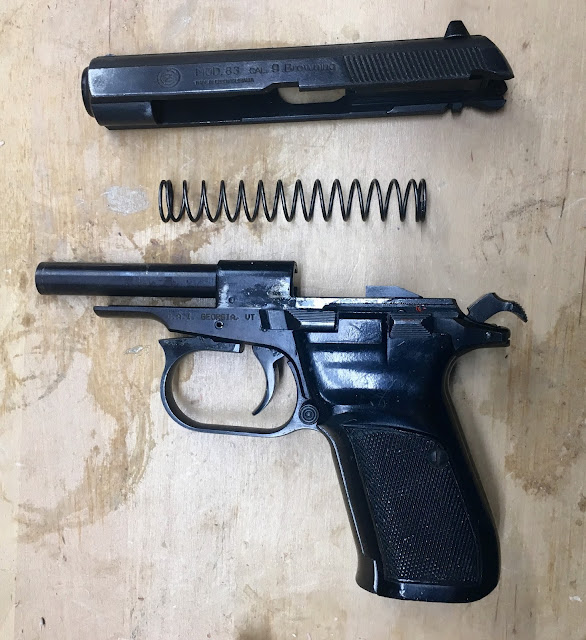In a competitive marketplace, products tend to converge over time into a small number of optimal designs. Ever notice how alike cars look these days? Guns are no different. Military and police pistol designs have all converged onto the polymer framed, double action only, striker fired, style pioneered by the H&K VP70 and popularized by Glock. (Yes, H&K's VP70 proceeded the first Gaston Glock design by a good six years.) There's good reason for this. Striker fired, polymer framed, DAO pistols are simple, straightforward, relatively cheap to make, and require much less training to use than a complex gun with safeties that switch mode from DA to SA and can be tricky to de-cock. The problem with them, though, is that they're all ugly. That doesn't matter to the military, but it does to collectors. (I do own a polymer framed, hammer fired, double action only pistol- the LCP- but only because it's about the smallest and lightest .380 there is.)
What I prefer to collect for the aesthetic enjoyment are pistols that look like they were crafted by gunsmiths rather than engineers, and were milled, not injection molded. They should have hammers, if at all possible. Lately I've been intrigued by older military and police guns that have been sold off by armies and police forces switching to the newer guns, and by guns used by the former client states of the USSR. These guns tend to show up in batches as they're imported, and usually go pretty cheaply until the supply dries up, at which point the price rises. The Polish LP83 I wrote about last month certainly fits that description, as does the Nagant Revolver I wrote about some time ago. I paid $120 for the Nagant, and now they're trading for $275-350, depends on the year and condition.
Last month I discovered the CZ82 and CZ83 pistols, which have shown up on the surplus market in the last year or so. CZ is of course one of the better gun makers in Europe, and have supplied military, police, and civilian markets with both handguns and long guns for not quite a century now. The CZ82 and 83 are really the same gun, the 82 in 9mm Makarov being the military and police model (where it was known as the Vz.82), and the 83 in.380 or .32ACP being the civilian model. The different models are pretty much identical other than the barrel and the magazine. Reportedly, the 82 and the .380 83 can swap magazines, which is not surprising, as the cartridges are very close in diameter and only vary in length by 1mm. Both 9mm Makarov and .380 variants can be loaded with 12 rounds. The .32ACP model will take 15.
It's a far cry from today's popular pocket .380s or even the PP and PPK. Thanks to the double stack magazine it has a fat grip that feels very comfortable to my hand and should help distribute recoil better than skinnier guns like the PPK. Everything about gun suggests classic design and quality. It's not a light gun; at 32oz empty it's 9oz heavier than the PPK and over 22oz heavier than my LCP. That's because it's made of steel, of course, and in a straight blowback gun, weight is your friend. It helps slow recoil velocity and better distribute the energy over time. The only other similarly hefty .380 I can recall in recent years was the Beretta 84, which was essentially a .380 version of the well-known Beretta 92. (Surplus ones were selling for $240 not too many years ago, and I should have grabbed one then.)
The CZ83 is a classic Double Action-Single Action pistol, like the Browning Hi-Power or the PPK. If the hammer is down, the gun is in double action mode. Once fired, the gun is in single action mode, and the safety can be applied so that it can be carried in Cooper's "condition one": Cocked and locked. There's no decocker lever, so safe decocking is a two handed affair: Place the weak hand thumb over the hammer, and pull the trigger. Lower the hammer off the half-cock notch, releasing the trigger as you do. There's a hammer block that's connected to the trigger, so once the trigger is no longer depressed, the hammer cannot strike the firing pin if accidentally released of if the gun is dropped.
The trigger itself is very smooth. Published figures put the SA pull at between 3 and 6 pounds, and DA at 13 pounds. Using my fish scale (I don't have a proper trigger scale) I measured both about 50% higher, but until I can borrow a friend's trigger gauge or a set of weights, I'll go with the published numbers.
The slide locks open on an empty magazine- classic John Browning:
It can be manually released, or, if the magazine is replaced with a loaded one and the slide is pulled back, it will automatically release.
Disassembly is very much influenced by the Walther PP/PPK- after removing the magazine and clearing the gun, you pull down on the front of the trigger guard. This takes significantly more effort than on the Walther guns, but when pulled down it locks into position with a solid and satisfying click:
With the guard pulled down, the slide can be pulled back, lifted up at the rear, and slid forward off the rails as with the typical blowback pistol:
Next: Shooting the CZ83




No comments:
Post a Comment